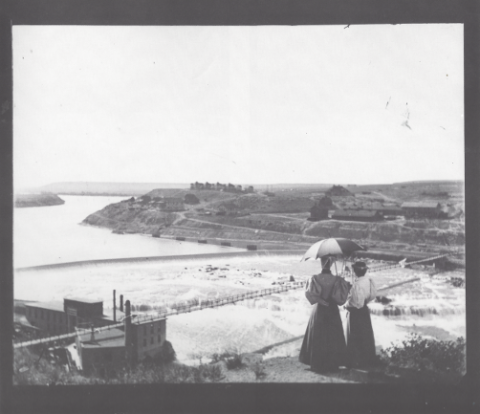Great Falls, Montana. July 31
Mrs. Pond. Great Falls, Montana. July 31
Clara, "Giant Springs." Great Falls, Montana. July 31
Mark Twain Archive, Elmira College courtesy of Kevin Mac Donnell, Austin, Texas.
The first human beings to live in the Great Falls area were Paleo-Indians who migrated into the region between 9,500 BCE and 8,270 BCE. The earliest inhabitants of North America entered Montana east of the Continental Divide between the mountains and the Laurentide ice sheet. The area remained only sparsely inhabited, however] Salish Indians would often hunt bison in the region on a seasonal basis, but no permanent settlements existed at or near Great Falls for much of prehistory. Around 1600, Piegan Blackfeet Indians, migrating west, entered the area, pushing the Salish back into the Rocky Mountains and claiming the site now known as Great Falls as their own. The Great Falls location remained the tribal territory of the Blackfeet until long after the United States claimed the region in 1803
Following the return passage of Lewis and Clark in 1806, there is no record of any white person visiting the site of the city of Great Falls until explorer and trapper Jim Bridger reached the area in 1822. Bridger and Major Andrew Henry led a fur-trading expedition to the future city location in April 1823 (and were attacked by Blackfeet Indians while camping at the site). British explorer Alexander Ross trapped around Great Falls in 1824. In 1838, a mapping expedition sent by the U.S. federal government and guided by Bridger spent four years in the area.
The Great Falls of the Missouri River marked the limit of the navigable section of the Missouri River for non-portagable watercraft, and the non-navigability of the falls was noted by the U.S. Supreme Court in its 2012 ruling against the State of Montana on the question of streambed ownership beneath several dams situated at the site of the falls. The first steamboat arrived at future site of the city in 1859.
Politically, the future site of Great Falls passed through numerous hands in the 19th century. It was part of the unincorporated frontier until May 30, 1854, when Congress established the Nebraska Territory. Indian attacks on white explorers and settlers dropped significantly after Isaac Stevens negotiated the Treaty of Hellgate in 1855, and white settlement in the area began to occur. On March 2, 1861, the site became part of the Dakota Territory. The Great Falls area was incorporated into the Idaho Territory on March 4, 1863, and then into the Montana Territory on May 28, 1864. It became part of the state of Montana upon that territory's admission to statehood on November 8, 1889.
Great Falls was founded in 1883. Businessman Paris Gibson visited the Great Falls of the Missouri River in 1880, and was deeply impressed by the possibilities for building a major industrial city near the falls with power provided by hydroelectricity. He returned in 1883 with friend Robert Vaughn and some surveyors and platted a permanent settlement the south side of the river. The city's first citizen, Silas Beachley, arrived later that year. With investments from railroad owner James J. Hill and Helena businessman Charles Arthur Broadwater, houses, a store, and a flour mill were established in 1884. The Great Falls post office was established on July 10, 1884, and Paris Gibson was named the first postmaster. A planing mill, lumber yard, bank, school, and newspaper were established in 1885. By 1887 the town had 1,200 citizens, and in October of that year the Great Northern Railway arrived in the city. Great Falls was incorporated on November 28, 1888.
Black Eagle Dam was built in 1890, and by 1912 Rainbow Dam and Volta Dam (now Ryan Dam) were all operating.
https://en.wikipedia.org/wiki/Great_Falls,_Montana
